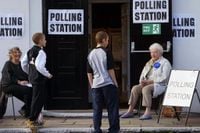After years of political debate and shifting allegiances, the United Kingdom is on the cusp of a major electoral transformation: the voting age is set to drop to 16, a move that could add 1.5 million teenagers to the electorate by the next general election in 2029. While Labour’s Keir Starmer has championed this change as a way to invigorate democracy and bring the UK in line with Scotland and Wales, leading pollsters are warning that the effects may be far more complicated—and potentially counterproductive for Labour—than many expect.
According to The Independent, the proposal was announced as part of a raft of government measures in July 2025. Starmer and his government have encouraged young people to engage with the future of their country. No 10 made it clear: the prime minister would “absolutely encourage them to be as engaged as they can be in the future of their country.”
But what seemed at first like a straightforward win for Labour is now drawing skepticism from across the political spectrum. Conservative peer and respected pollster Robert Hayward told The Independent, “I just don’t think the policy will be as beneficial as the Labour Party thought when they first proposed it. My expectation, in the multi-party political field that we have at the moment, is that the non-mainstream, non-legacy parties – such as Reform, the Green Party and Corbyn’s party – will be the beneficiaries of younger people’s willingness to vote away from the traditional parties.”
Martin Baxter, director at polling firm Electoral Calculus, echoed this view, noting, “It could be that Labour’s plan for votes for 16 and 17 year olds – which did look a bit like semi-naked tilting the scales in Labour’s own favour – might backfire a little bit, if Reform and Corbyn attract those new voters.”
Indeed, the numbers behind the new teenage voters are striking but nuanced. While 1.5 million new voters sounds like a tidal wave, they would make up only about 2% of the overall electorate. Louis O’Geran, research and communications associate at More in Common UK, pointed out, “In most constituencies they won’t make a difference to the outcome.” Yet, in an era of increasingly fragmented politics, even a small cohort of new voters could tip the balance in tightly contested seats. O’Geran explained, “Their votes could help determine the outcome of a handful of tight races across the country.”
What’s more, the preferences of these young voters are anything but monolithic. O’Geran highlighted a notable gender divide: “Gen Z men are more likely to back Labour and Reform, while the Green Party often leads among Gen Z women.” With Jeremy Corbyn’s new party expected to focus on green issues, there’s speculation that young women could be drawn to this emerging force—if it manages to establish itself in time for 2029. Lord Hayward described the appeal of Corbyn’s party to younger voters as rooted in its “none of the above” status, reflecting a broader trend of youth voting for alternatives to the mainstream.
Yet, the full impact of Corbyn’s party remains unclear. As Baxter noted, “At the moment, I’m not seeing hard data on the 16 and 17-year-old vote – or really, the people who will be 16 or 17 in 2029. It’s slightly weird because these people are currently 12 and 13, so their political views are perhaps not fully developed yet. But is there the potential, when they do grow up to be 16 and 17, for Jeremy Corbyn to get votes? Yes.”
Geographically, the influence of new teenage voters is expected to be fairly consistent across the UK, with only a few exceptions. The south coast and southwest—known as “retirement belts”—and inner London’s “ultra expensive zones” may see less impact, as these areas have fewer young people. Most constituencies will experience a “reasonably average impact,” according to Lord Hayward.
However, in urban seats where Labour faces strong independent challengers—particularly those dubbed “Gaza Independents”—the influx of young voters could prove decisive. O’Geran noted that there are seven constituencies where Labour’s majority over an independent candidate is smaller than the number of 16 and 17-year-olds in the seat. In these places, the new voting bloc could “subtly reshape the political map over time.”
But, as with so much in politics, turnout is everything. The 2024 general election saw a nearly 10% drop in turnout across the board, with the lowest participation among the youngest eligible voters. Lord Hayward cautioned, “There is no reason for believing an even younger age group will not follow the trends of those immediately above them, by being actually a very low turnout demographic cohort.” Declining birth rates may further shrink this group’s potential impact in the years ahead.
Meanwhile, the broader right-of-center political landscape remains in flux. After the Conservative Party’s crushing defeat in 2024, UK conservatism is split between a rump of traditionalists and those who have migrated to Nigel Farage’s Reform UK. As one anonymous conservative commentator wrote in The Spectator, “Reform UK has been the main beneficiary of the Labour collapse and ongoing Conservative malaise, consistently leading opinion polls and winning a previously safe Labour seat in a by-election in May.”
Yet, Reform UK is not immune to the same internal divisions that plagued the Conservatives. Personality clashes, leadership disputes, and policy disagreements have already resulted in expulsions and resignations. The party’s stance on contentious social issues, such as assisted suicide and abortion, has exposed ideological rifts between socially conservative and more liberal factions. The commentator observed, “The fear is that Reform will end up, as the Tories did, split between socially liberal, globalist libertarians and traditional social conservatives.”
With Kemi Badenoch now leading the Conservatives, the party has continued to tilt toward the centrist “One Nation” wing, much to the frustration of social conservatives. Badenoch’s shadow Cabinet appointments have reinforced this balance, and the party’s polling has slumped to around 17%, putting it in third place. According to The Spectator, “There remains a suspicion that the Tory brand is irreversibly tarnished.”
As Reform UK rises, some on the right are calling for a new movement—perhaps a “Reformed Conservatives” alliance—to unite the fractured conservative base. The anonymous commentator mused, “For the likes of Robert Jenrick, who has largely assuaged doubts about the sincerity of his conversion to conservative thinking, the national interest may require swallowing pride and submitting to a Farage-led Party.” Whether such an alliance can materialize before the next election remains uncertain, but the prize—a revitalized, unified conservative movement—appears tantalizingly close.
For now, the UK’s political future hangs in the balance. Labour’s attempt to broaden the electorate may have unintended consequences, while the right remains mired in division and soul-searching. As the next generation of voters prepares to enter the fray, all sides are watching closely, hoping to harness the energy—and unpredictability—of youth.




